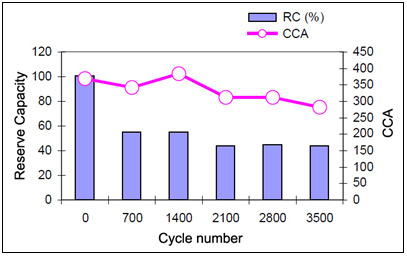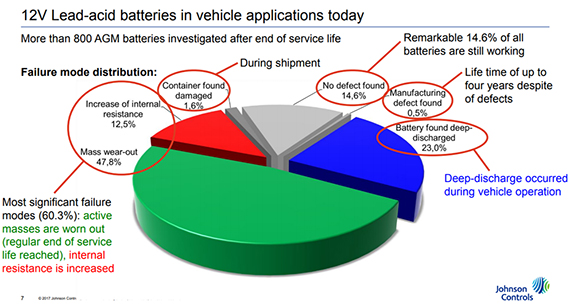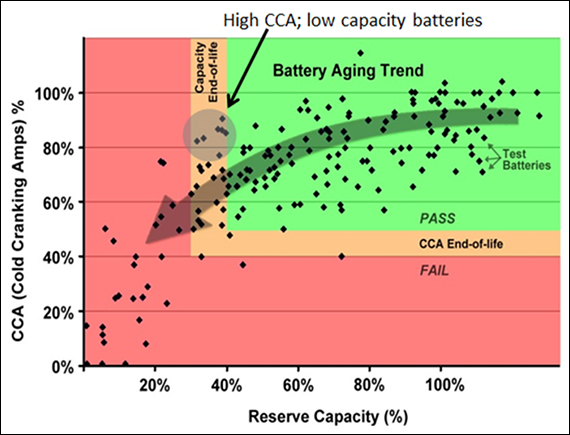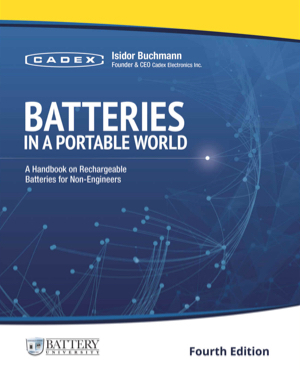How Temperature Affects Battery Life Background Information
Larn near the temperature and how get-go-stop shortens the life of a starter battery
Heat is a killer of all batteries, but loftier temperatures cannot always be avoided. This is the case with a bombardment inside a laptop, a starter battery under the hood of a motorcar and stationary batteries in a tin shelter under the hot sunday. As a guideline, each 8°C (xv°F) ascent in temperature cuts the life of a sealed lead acrid battery in half. This ways that a VRLA battery for stationary applications specified to concluding for 10 years at 25°C (77°F) would just live five years if continuously exposed to 33°C (92°F) and 30 months if kept at a constant desert temperature of 41°C (106°F). In one case the battery is damaged by heat, the capacity cannot be restored.
According to the 2010 BCI Failure Fashion Written report, starter batteries accept go more heat-resistant. In the 2000 report, a rise in temperature of 7°C (12°F) affected battery life by roughly one twelvemonth; in 2010 the estrus tolerance has been widened to 12°C (22°F). Other statistics reveal that in 1962, a starter bombardment lasted 34 months; technical improvements increased the life expectancy in 2000 to 41 months. In 2010, BCI reported an average historic period of 55 months for starter batteries, with the cooler North attaining 59 months and the warmer South 47 months. Colloquial bear witness in 2015 revealed that a battery kept in the trunk of a motorcar lasted one year longer than if positioned in the engine compartment.
The life of a battery also depends on the activity, and the service life is shortened if the battery is stressed with frequent discharge. Cranking the engine a few times a 24-hour interval poses little stress on a starter battery, simply this changes in the start-finish operation of a micro-hybrid. The micro-hybrid turns the internal combustion engine (Ice) off at ruby traffic lights and restarts information technology when the traffic flows again, resulting in about ii,000 micro-cycles per year. Information obtained from car manufacturers shows a capacity drop to about sixty percent after ii years of use. To increase bicycle life, automakers use specialty AGM and other systems(See BU-211: Alternate Bombardment Systems)
Figure ane shows a capacity driblet from 100 percent to almost fifty percent later the battery had been exposed to 700 micro cycles. The faux start-stop examination was performed in the Cadex laboratories. CCA remains high and but shows a decline afterwards near 2,000 cycles.

The capacity drops to about 50 percent after 2 years of use. AGM bombardment is more robust.
Exam method:
The battery was fully charged and then discharged to 70% to resemble SoC of a micro hybrid in existent life. The bombardment was then discharged at 25A for 40 seconds to simulate the engine off with the headlights on. To simulate cranking and driving, the battery was briefly discharged at 400A then recharged. CCA was taken with the Spectro CA-12.
When connected in series, the voltage of each cell must exist uniform, and this is especially important in large stationary battery systems. With fourth dimension, private cells autumn out of line just applying an equalizing accuse every 6 months or then should bring the cells back to similar voltage levels. (See BU-404: Equalizing Charge) What makes this service so hard is providing the right remedy to each cell. While equalizing volition heave the needy cells, the healthy cell gets stressed if the equalizing charge is applied carelessly. Gel and AGM batteries have lower overcharge credence than the flooded version and different equalizing weather utilize.
Flooded atomic number 82 acrid batteries are one of the about reliable systems and are well suited for hot climates. With good maintenance these batteries last up to 20 years. The disadvantages are the need for watering and proficient ventilation.
When VRLA was introduced in the 1980s, manufacturers claimed like life expectancy to the flooded systems, and the telecom industry was enticed to switch to these maintenance-free batteries. By mid-1990 information technology became credible that the life of VRLA did not live up to the flooded type; the typical service life of the VRLA is v–10 years, less than one-half of the flooded equivalent. It was furthermore noticed that exposing VRLA batteries to temperatures in a higher place 40°C (104°F) could cause a thermal runaway due to dry-out.
North American Automotive Battery Failures
The 2005 failure-mode study was carried out by Douglas, East Penn., Exide Technologies and Johnson Controls. The sample battery pool included 2681 batteries tested between 2003 and 2004. The highlights include:
- Bombardment life on boilerplate was 50 months. This is an improvement from earlier years that only had 41 months (2000) and 34 months (1962). Improved materials are prolonging battery life.
- Northern and southern areas in North America deliver unlike life spans. Batteries in warmer climates die sooner than in libation regions. See Effigy 2.
- Shorted cells and filigree failures are the leading causes of battery failures in this survey.

Batteries used in the northern area of Northward America last longer than those in the southward.
European Automotive Bombardment Failure
Figure 3 summarizes the failure-fashion distribution of more 800 AGM starter batteries carried out by Johnson Controls Power Solutions EMEA. The results were presented at AABC Europe 2017 in Mainz, Federal republic of germany.

The largest failure is mass habiliment-out as a function of usage reflecting in capacity fade and a ascension of internal resistance.
Tabular array 1 summarizes the cause of failure derived from the JCI written report.
| Ratio | Crusade | Diagnostics |
|---|---|---|
| 47.8% | Mass wear-out, normal use | Loss of capacity, rising in resistance. Capacity estimation is most predictive |
| 23% | Bombardment has low charge | Employ voltmeter in open excursion when bombardment has rested |
| 14.half-dozen% | No fault plant | Better examination methods puts these batteries dorsum in service |
| 12.5% | High internal resistance | Can be identified with battery testers measuring internal resistance |
| 1.half dozen% | Container damaged | Cannot exist repaired in about cases |
| 0.5% | Manufacturing defect | Manufacturers merits that near warranty causes are user induced. |
The above JCI study identifying finish of battery life provides similar results to the test performed by a German language luxury car maker in ca 2007 involving 175 starter batteries. In this test, heat failed batteries (loftier internal resistance) were eliminated and the results were plotted in Figure 4. The horizontal axis represents chapters; internal resistance correlating to CCA is on the vertical centrality. CCA was measured co-ordinate to DIN and IEC standards.
The stop-of-life of most batteries occurs past passing through the Capacity Line located on the left of the green field in Figure 4. Very few batteries failed by dropping through the CCA Line. Chapters fade occurs through normal use generally due to loss of agile mass. Auxiliary ability, such as start-stop, heating elements and mechanical door deportment accelerate capacity loss. Increased internal resistance is a side effect of the active mass loss, but capacity estimation is the more reliable predictor of finish-of-life. This is highlighted with the batteries sitting gray dot. Also come across: BU-806: Tracking Battery Capacity and Resistance every bit role of Aging

Most batteries pass through the Capacity Line; few fail because of low CCA. The batteries were trunk mounted and driven in a moderate climate.
Note: Test was done by a German luxury car maker. Heat damaged batteries were eliminated.
Test Method: Capacity and CCA were tested according to DIN and IEC standards.
Comments
Some makers of battery testers claim to measuring chapters when simply reading the internal resistance. Advertizement features that lay outside of the equipment'due south capabilities confuses the manufacture into believing that complex tests can be done with bones methods. Resistance-based instruments can place a dying or expressionless battery, but so does the user by poor cranking performance. Encounter also BU-905: Testing Lead Acid Batteries
References
[1] Courtesy of Cadex, 2010
[2] Source: Survey carried out by Douglas, East Penn., Exide Technologies, and Johnson Controls
[3] Source: Johnson Controls Power Solutions EMEA at AABC Europe 2017 in Mainz, Germany

Batteries In A Portable World
How Temperature Affects Battery Life Background Information,
Source: https://batteryuniversity.com/article/bu-806a-how-heat-and-loading-affect-battery-life
Posted by: barteltdoccap.blogspot.com



0 Response to "How Temperature Affects Battery Life Background Information"
Post a Comment